This article was written by Lisa Bergson, executive director of WHALE (Waterfront Historical Area LeaguE). This is the second in a series of articles about New Bedford being ‘Not Just Anywhere.’ You can read the first article here.
“Nowhere in all America will you find more patrician-like houses; parks and gardens more opulent, than in New Bedford… all these brave houses and flowery gardens came from the Atlantic, Pacific, and Indian Oceans.” – From Herman Melville’s Moby Dick.
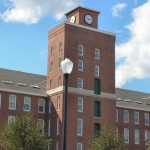
Herman Mellville hit the proverbial nail right on the head when he immortalized New Bedford in his classic novel, Moby Dick. Whaling brought the first period of great wealth to New Bedford, and with it some of the most magnificent and diverse architecture in the Northeast. This rich, preserved architecture (and the ensuing character it creates) makes New Bedford a special place to live, to work, and to visit. It makes New Bedford ‘Not Just Anywhere.’
New Bedford has several significant buildings built by architectural masters, such as Russell Warren, Richard Upjohn, and Alexander Jackson Davis. We also have buildings built by noted local architects like Nat C. Smith, Samuel Hunt, and Caleb and Edgar Hammond. Indeed, throughout New Bedford, you can see the grand examples of various architectural styles, as well as smaller, more modest ones as well. No matter where you are in the city, you are likely to see magnificent examples of architecture styles such as Federal, Greek Revival, Gothic Revival, Italianate, and Queen Anne.
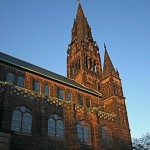
In New Bedford, preservation efforts have been led by the Waterfront Historic Area LeaguE (WHALE). In the historic core of New Bedford alone, more than 20 buildings were saved by WHALE from demolition, fire, or neglect. WHALE’s preservation work has changed the way New Bedford looks forever, and has ensured that New Bedford remains a special place, rich in history and architecture – a place that is Not Just Anywhere.
Below you will find a list of different types of architecture that can be seen in New Bedford, as well as some examples of each. Luckily, you don’t have to be a architect to appreciate a beautiful building. They are all around us in the city, and with this mini-guide to architecture in New Bedford, you’ll be able to recognize the details that make each special.
Federal (1780-1820)
Federal-style houses are well balanced with small-paned windows, and have a low-pitched roof and a smooth facade. They often have a fanlight window and a triangular pediment over the front door. Other character-defining features include a rectangular portico supported by Doric columns, corner boards, and sidelights.
Henry Beetle House c.1804
Threatened by demolition because it was in the path of the Route 18 extension, this former spar maker’s Federal period home was moved by WHALE to a once-vacant lot in 1972 and sold to owners who restored it.
This 550-ton brick and stone mansion was rescued by WHALE to prevent its demolition and moved down William Street to its present site. It became stuck in the middle of the street during the blizzard of 1978 and remained there for one month, until it was moved to its current location. This brick mansion residence is an outstanding example of New Bedford’s prosperity during the golden age of whaling.
Greek Revival (1820-1860)
Double Bank Building c. 1831
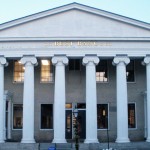 This Greek Revival building is located at the junction of Water and William Street, and is perhaps the most impressive building in New Bedford Whaling National Historical Park. Designed by Russell Warren and located in what was once the financial center of New Bedford during the heyday of whaling, the Double Bank building was built to house two prominent banking institutions: Merchants Bank and Mechanics Bank. In fact, the rival banks hired two different builders to construct the building and due to a disagreement between the builders. There is a slight difference between the vertical slope of the four columns on the left and the four on the right, further distinguishing the two banks.
This Greek Revival building is located at the junction of Water and William Street, and is perhaps the most impressive building in New Bedford Whaling National Historical Park. Designed by Russell Warren and located in what was once the financial center of New Bedford during the heyday of whaling, the Double Bank building was built to house two prominent banking institutions: Merchants Bank and Mechanics Bank. In fact, the rival banks hired two different builders to construct the building and due to a disagreement between the builders. There is a slight difference between the vertical slope of the four columns on the left and the four on the right, further distinguishing the two banks.
This historic building is one of our grand examples of Greek Revival architecture, with its character defining features including pediment, frieze, cornice details (uppermost section of moldings along the top of a wall or just below a roof), full-height Ionic columns, and polished granite steps and facade. Greek Revival houses are modeled after the architecture of Ancient Greece, and over time became symbols of America’s strength and democracy.
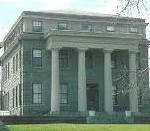 Grinnell Mansion and Congregate Home for the Elderly c.1831
Grinnell Mansion and Congregate Home for the Elderly c.1831
Designed by Architect Russell Warren for U.S. Congressman Joseph Grinnell, this Greek Revival-style granite mansion, located on County Street, had been abandoned and deteriorating for 30 years when WHALE rescued it in 1987. It epitomizes the fortunes that were made in the golden age of whaling. Today it serves as congregate housing for low income, elderly residents. Character defining features are its Doric columns along the front entry porch, the tall 3rd story frieze, and rough-hewn granite facade.
Rotch-Jones-Duff House and Garden Museum c.1834
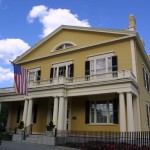 Designed by Richard Upjohn for William Rotch Jr., the house is the last whaling merchant’s home in New Bedford with its original, intact gardens, dating back to the whaling era. The historic property is a National Historic Landmark, recognized for its significance to all Americans, due to its ties to whaling and its magnificent architecture. WHALE rescued the building from inappropriate development, which called for the house to become a boarding house and restaurant and the gardens paved over for a parking lot in 1981. After an exterior restoration, WHALE helped establish the nonprofit that has since managed the Rotch-Jones- Duff House & Garden Museum, which is a cultural icon in New Bedford.
Designed by Richard Upjohn for William Rotch Jr., the house is the last whaling merchant’s home in New Bedford with its original, intact gardens, dating back to the whaling era. The historic property is a National Historic Landmark, recognized for its significance to all Americans, due to its ties to whaling and its magnificent architecture. WHALE rescued the building from inappropriate development, which called for the house to become a boarding house and restaurant and the gardens paved over for a parking lot in 1981. After an exterior restoration, WHALE helped establish the nonprofit that has since managed the Rotch-Jones- Duff House & Garden Museum, which is a cultural icon in New Bedford.
Gothic Revival (1830-1860)
Here in New Bedford we have what may be the finest example of Gothic Revival architecture in the United States – the William J. Rotch Gothic Cottage. Gothic Revival houses have very steep gable roofs and fancy verge boards (called ‘gingerbread’), which trim the roof. Some were even built to resemble churches.
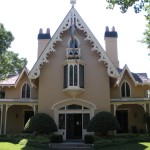 William J. Rotch Gothic Cottage c.1845
William J. Rotch Gothic Cottage c.1845
Designed by Alexander Jackson Davis, the William J. Rotch Gothic Cottage is one of the finest Gothic cottages in the United States. The house received immediate national attention as a masterwork of architecture through its inclusion in A. J. Downing’s seminal The Architecture of Country Houses (1850). The home is a masterwork of A. J. Davis and is one of the best documented, intact Gothic Revival cottages in America. The Rotch Gothic Cottage is a National Historic Landmark – one of six in New Bedford – recognizing its significance and importance to all Americans.
Other architectural styles are also prevalent in our neighborhoods in New Bedford. If you look, you will find Octagon, Italianate, Four Square, Queen Anne, Stick Style,two and three-decker houses, and so much more. So the next time you take a walk or go for a drive, take a look around and see firsthand why New Bedford’s architecture makes us a special place. See why New Bedford is Not Just Anywhere.
 New Bedford Guide Your Guide to New Bedford and South Coast, MA
New Bedford Guide Your Guide to New Bedford and South Coast, MA

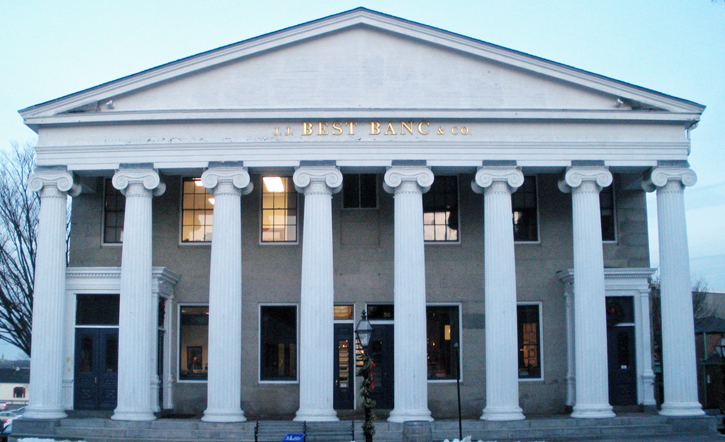

















https://www.facebook.com/pages/Fairhaven-Mills/106292056114661?bookmark_t=page